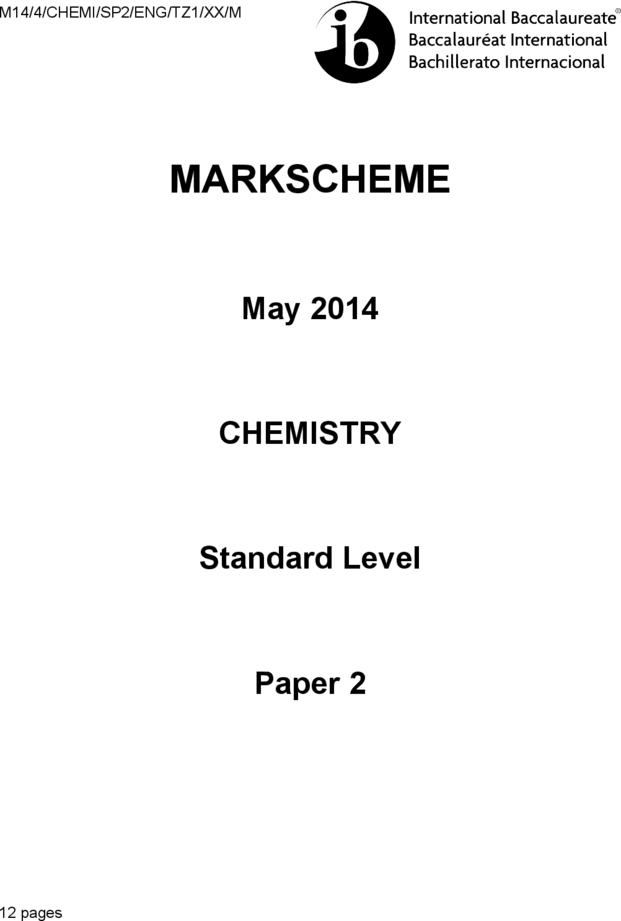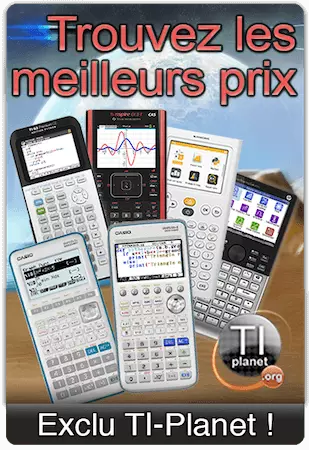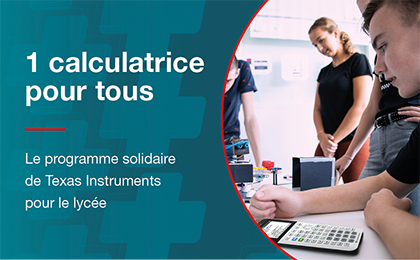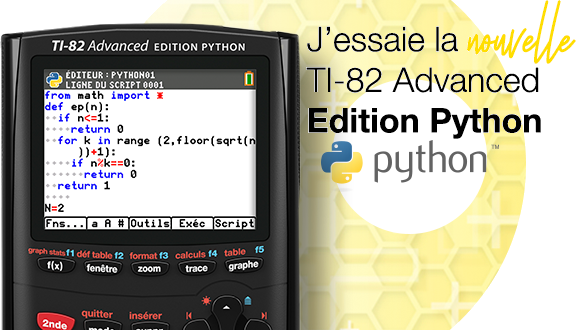fourteen1
File hierarchy
| Downloads | ||||||
| Files created online | (38519) | |||||
| TI-Nspire | (24990) | |||||
| mViewer GX Creator Ndless | (972) | |||||
DownloadTélécharger
Actions
Vote :
ScreenshotAperçu

Informations
Catégorie :Category: mViewer GX Creator Ndless TI-Nspire
Auteur Author: onelastride
Type : Image nécessitant un lecteur
Page(s) : 12
Taille Size: 548.99 Ko KB
Mis en ligne Uploaded: 09/04/2015 - 04:04:39
Uploadeur Uploader: onelastride (Profil)
Téléchargements Downloads: 537
Visibilité Visibility: Archive publique
Shortlink : http://ti-pla.net/a186673
Type : Image nécessitant un lecteur
Page(s) : 12
Taille Size: 548.99 Ko KB
Mis en ligne Uploaded: 09/04/2015 - 04:04:39
Uploadeur Uploader: onelastride (Profil)
Téléchargements Downloads: 537
Visibilité Visibility: Archive publique
Shortlink : http://ti-pla.net/a186673
Description
M14/4/CHEMI/SP2/ENG/TZ1/XX/M
MARKSCHEME
May 2014
CHEMISTRY
Standard Level
Paper 2
12 pages
–2– M14/4/CHEMI/SP2/ENG/TZ1/XX/M
It is the property of the International Baccalaureate and must not
be reproduced or distributed to any other person without the
authorization of the IB Assessment Centre.
–3– M14/4/CHEMI/SP2/ENG/TZ1/XX/M
Subject Details: Chemistry SL Paper 2 Markscheme
Mark Allocation
Candidates are required to answer ALL questions in Section A [30 marks] and ONE question in
Section B [20 marks]. Maximum total = [50 marks].
1. A markscheme often has more marking points than the total allows. This is intentional.
2. Each marking point has a separate line and the end is shown by means of a semicolon (;).
3. An alternative answer or wording is indicated in the markscheme by a slash (/). Either wording can
be accepted.
4. Words in brackets ( ) in the markscheme are not necessary to gain the mark.
5. Words that are underlined are essential for the mark.
6. The order of marking points does not have to be as in the markscheme, unless stated otherwise.
7. If the candidate’s answer has the same “meaning” or can be clearly interpreted as being of
equivalent significance, detail and validity as that in the markscheme then award the mark.
Where this point is considered to be particularly relevant in a question it is emphasized by
OWTTE (or words to that effect).
8. Remember that many candidates are writing in a second language. Effective communication is more
important than grammatical accuracy.
9. Occasionally, a part of a question may require an answer that is required for subsequent
marking points. If an error is made in the first marking point then it should be penalized. However,
if the incorrect answer is used correctly in subsequent marking points then follow through marks
should be awarded. When marking, indicate this by adding ECF (error carried forward) on the
script.
10. Do not penalize candidates for errors in units or significant figures, unless it is specifically referred
to in the markscheme.
11. If a question specifically asks for the name of a substance, do not award a mark for a correct
formula unless directed otherwise in the markscheme, similarly, if the formula is specifically asked
for, unless directed otherwise in the markscheme do not award a mark for a correct name.
12. If a question asks for an equation for a reaction, a balanced symbol equation is usually expected, do
not award a mark for a word equation or an unbalanced equation unless directed otherwise in the
markscheme.
13. Ignore missing or incorrect state symbols in an equation unless directed otherwise in the
markscheme.
–4– M14/4/CHEMI/SP2/ENG/TZ1/XX/M
SECTION A
1. (a) (i) 0.10
Volume of hydrogen / dm3
I
0.05
II
0.0
0 21 3 4
Time / min
I: line which is steeper/increases faster and finishes at the same height;
II: line which is less steep/increases more slowly and finishes at the same
height; [2]
(ii) mass of hydrogen produced is very small (so not accurate) / decrease in
mass is very small (so not accurate); [1]
3.01
(b) (i) n(MgSO 4 ) 0.0250 (mol) ; [1]
120.37
(ii) energy released 50.0 4.18 9.7 2027 (J) / 2.027 (kJ) ;
H1 81(kJ mol 1 ) ; [2]
Award [2] for correct answer.
Award [2] if 53.01 is used giving an answer of –86 (kJ mol–1).
Award [1 max] for +81/81/+86/86 (kJ mol−1).
Award [1 max] for –81000/–86000 if units are stated as J mol−1.
Allow answers to 3 significant figures.
(c) (i) H ( H1 H 2 ) 99 (kJ mol 1 ) [1]
Award [1] if –86 is used giving an answer of –104 (kJ mol−1).
(103 99)
(ii) 100 3.9 % ; [1]
103
Accept answer of 2.9 % if –100 used.
Award [1] if –104 is used giving an answer of 1.0% .
Accept correct answers which are not to 1 decimal place.
–5– M14/4/CHEMI/SP2/ENG/TZ1/XX/M
(d) MgSO4 not completely anhydrous / OWTTE;
MgSO4 is impure;
heat loss to the atmosphere/surroundings;
specific heat capacity of solution is taken as that of pure water;
experiment was done once only so it is not scientific;
density of solution is taken to be 1 g cm–3;
mass of 7H 2 O ignored in calculation;
uncertainty of thermometer is high so temperature change is unreliable;
literature values determined under standard conditions but this experiment is not;
all solid not dissolved; [2 max]
(e) (i) H 2SO4 (aq) MgCO3 (s) MgSO4 (aq) CO 2 (g) H 2O (l) ; [1]
Ignore state symbols.
Do not accept H2CO3.
(ii)
;
Accept crosses, lines or dots as electron pairs.
Accept any correct resonance structure.
Award [0] if structure is drawn without brackets and charge.
Award [0] if lone pairs not shown on O atoms.
shape: trigonal/triangular planar;
bond angle: 120 ; [3]
Accept answers trigonal/triangular planar and 120 if M1 incorrect, but no
other answer should be given credit.
–6– M14/4/CHEMI/SP2/ENG/TZ1/XX/M
2. (a) Q: creates positive ions/cations / electron is knocked off atom / OWTTE;
by bombardment of electrons;
S: ions deflected by an (external) magnetic field;
deflection of ions depends on mass/m/z (and charge) / heavier ions are deflected
less than lighter ions / more highly charged ions are deflected more than less
highly charged ions; [4]
Award [1 max] for simply stating ionization and deflection.
1
(b) (i) ratio of average/mean mass of atom to of mass of C–12 (isotope) /
12
average/mean mass of atom on scale where one atom of C–12 has mass of
1
12 / weighted average/mean mass of isotopes of element compared to
12
of mass of C–12 / OWTTE; [1]
Award no mark if “element” is used instead of “atom” in first two alternatives.
1
Allow “mass of an atom relative to the mass of of C–12”.
12
(ii) ( Ar ) 0.7899 24 0.1000 25 0.1101 26 ;
24.32 ; [2]
Award [2] for correct final answer.
Award [1 max] for 24.31 with correct working.
Award [0] for 24.31 (Data Booklet value) if working is incorrect or no
working is shown.
Final answer must be to 2 decimal places to score [2].
[N 2 O 4 (g)]
3. (a) ( K c ) ; [1]
[NO 2 (g)]2
Ignore state symbols.
(b) (i) equilibrium shifts to left as there are more moles (of gas) on reactant side;
no change to Kc as it is a constant at fixed temperature / OWTTE; [2]
Award [1 max] for correct equilibrium shift and Kc change if no
explanation given.
(ii) equilibrium shifts to left since reaction is exothermic/ΔH negative / reverse
reaction is endothermic/absorbs heat;
value of Kc decreases because less N 2 O 4 and more NO 2 / OWTTE; [2]
Award [1 max] for correct equilibrium shitft and Kc change if no
explanation given.
–7– M14/4/CHEMI/SP2/ENG/TZ1/XX/M
4. (a) butane < propanal < ethanoic acid / CH3CH 2 CH 2 CH3 < CH3CH 2CHO < CH3COOH ; [1]
(b) all three compounds have similar molar masses;
butane non-polar so no attraction to water molecules/insoluble;
propanal polar so can form some interactions with water molecules;
ethanoic acid can form (more) hydrogen bonds with water molecules / OWTTE; [3 max]
Award [1 max] for butane is non-polar and propanal and ethanoic acid are
both polar.
–8– M14/4/CHEMI/SP2/ENG/TZ1/XX/M
SECTION B
5. (a) (i) 2Na (s) 2H 2O (l) H 2 (g) 2NaOH (aq) / Na (s) H 2 O (l) 12 H 2 (g) NaOH (aq) ; [1]
Ignore state symbols.
(ii) bubbles/gas produced / crackling / fizzing / OWTTE;
temperature (of water) increases;
sodium floats on water / melts into a ball / disappears / OWTTE;
sharp smell;
small yellow sparks; [2 max]
(iii) K > Na > Li; [1]
(b) (i) Br2 (aq) : no change;
KBr (aq): colour change / from colourless to red/yellow/orange/brown; [2]
(ii) 2Br (aq) Br2 (aq) 2e ;
Cl 2 (g) 2e 2Cl (aq) ; [2]
Ignore state symbols.
Accept e instead of e–.
(c) (i) HF has hydrogen bonds (between molecules); [1]
(ii) strength of van der Waals’/London/dispersion forces increases;
as mass/size/number of electrons of halogen atom/molecule increases; [2]
(d) Cl– has an extra electron so extra repulsions push electrons farther apart / Cl– and
Cl have same number of occupied electron shells and Cl– has one more electron
than protons / Cl has 17 electrons and 17 protons and Cl– has 18 electrons and 17
protons so electrons are held less tightly / Cl 2, 8, 7 and Cl– 2, 8, 8 so electrons
are held less tightly; [1]
(e) (i) Na 2O ionic and SO3 covalent;
Na 2O has ions which are free to move in the liquid state;
SO3 has no free charged particles; [3]
Accept “no free moving ions” / “no delocalized electrons”.
(ii) Na2O basic and SO3 acidic; [1]
(iii) Na 2 O (s) H 2 O (l) 2NaOH (aq) ;
SO3 (g) H 2O (l) H 2SO4 (aq) ; [2]
Ignore state symbols.
(iv) oxidation of SO 2 by atmospheric oxygen / combustion of sulfur-containing
fossil fuel/heavy industry/power plants/combustion engine;
acid rain / pollution of lakes and rivers / localized pollution in cities; [2]
Accept specific examples of environmental effects such as corrosion of
marble / limestone statues.
–9– M14/4/CHEMI/SP2/ENG/TZ1/XX/M
6. (a) loss of electrons; [1]
(b) (i) 6/VI ; [1]
Do not award mark if incorrect notation used, ie, 6 , 6+ or –6.
(ii) C 4 H 9 OH (l) C 4 H 8O (l) 2H (aq) 2e ; [1]
Ignore state symbols.
(iii) 3C 4 H 9 OH (l) Cr2 O 7 2 (aq) 8H (aq) 3C 4 H 8O (l) 2Cr 3 (aq) 7H 2 O (l) ; [1]
Ignore state symbols.
(iv) CH3CH 2 CH 2 CH 2OH ;
(CH 3 ) 2 CHCH 2 OH ; [2]
Accept full or condensed structural formulas.
(v) (CH 3 )3COH ;
2-methylpropan-2-ol;
Allow 2-methyl-2-propanol , methylpropan-2-ol, methyl-2-propanol.
tertiary; [3]
(vi) C4 H9OH 6O2 4CO2 5H2O / (CH3 )3COH 6O2 4CO2 5H2O
correct reactants and products;
correct balancing; [2]
(c) (i) (DC) power supply
– +
e– e–
– +
KBr (l)
reduction oxidation
(DC) power supply / battery;
electrodes labelled as +/anode or –/cathode and electron flow;
reduction at negative electrode (cathode) / oxidation at positive electrode
(anode);
electrolyte / molten KBr/KBr(l) / K (l) and Br (l) ; [4]
– 10 – M14/4/CHEMI/SP2/ENG/TZ1/XX/M
(ii) Positive electrode (anode):
2Br (l) Br2 (l) 2e ;
Negative electrode (cathode):
K (l) e K (l) ; [2]
Award [1 max] if correct half-equations are given at the wrong electrodes.
Allow e instead of e–.
Ignore state symbols.
Penalize equilibrium sign once only.
(iii) positive ions move towards negative electrode (cathode) and negative ions
move towards positive electrode (anode) / ions move to oppositely charged
electrode / negative ions give up electrons at positive electrode and positive
ions gain electrons at negative electrode; [1]
(d) (i) Z < W < X < Y; [1]
Accept Y > X > W > Z.
(ii) X (s) Z2 (aq) X 2 (aq) Z(s) ; [1]
Ignore state symbols.
Accept X(s) + ZCl2(aq) XCl2(aq) + Z(s).
– 11 – M14/4/CHEMI/SP2/ENG/TZ1/XX/M
7. (a) HCl is a strong acid and CH3COOH is a weak acid so HCl has higher
conductivity / HCl dissociates completely in water and CH3COOH does not, so
HCl has higher conductivity / HCl is stronger acid (than CH3COOH) so has
higher [H+] and higher conductivity; [1]
(b) (i) CH 3COOH (aq) HCO3 (aq) CH 3COO (aq) H 2 O (l) CO 2 (g) ; [1]
Accept NaHCO3(aq) and CH3COONa (aq) instead of ions.
Ignore state symbols.
(ii) n (CH3COOH) 0.00500 (mol) and n (NaHCO3 ) 0.00450 (mol) ;
NaHCO3 is limiting; [2]
(iii) n(CO 2 ) n (NaHCO3 ) 0.00450 (mol) ;
m (CO 2 ) 0.00450 44.01 0.198(g) ; [2]
Award [2] for correct final answer.
(c) (i) T 363K and V 9.50 105 m3 ;
Accept V 9.5 10 2 dm 3 if P is used as 101 kPa in calculation.
PV 1.01105 9.50 105
n ;
RT 8.31 363
3.18 103 (mol) ; [3]
Award [3] for correct final answer.
m 0.348
(ii) M 3
109 (g mol1 ) ; [1]
n 3.18 10
(d) (i) (dilute aqueous) NaOH/sodium hydroxide / KOH/potassium hydroxide; [1]
Do not accept hydroxide/OH–.
(ii)
curly arrow going from lone pair/negative charge on O in HO– to C;
Do not allow curly arrow originating on H in HO–.
curly arrow showing Br leaving;
Accept curly arrow either going from bond between C and Br to Br in
bromoethane or in the transition state.
representation of transition state showing negative charge, square brackets
and partial bonds;
Do not penalize if HO and Br are not at 180 to each other.
Do not award M3 if OH—C bond is represented. [3]
– 12 – M14/4/CHEMI/SP2/ENG/TZ1/XX/M
(e) (i) HBr;
room temperature / anhydrous/dry; [2]
Allow heat/warm.
(ii) bonds broken:
1(C=C) 1(H–Br) / (612 366 )978 (kJ) ;
Accept 2630 (kJ).
MARKSCHEME
May 2014
CHEMISTRY
Standard Level
Paper 2
12 pages
–2– M14/4/CHEMI/SP2/ENG/TZ1/XX/M
It is the property of the International Baccalaureate and must not
be reproduced or distributed to any other person without the
authorization of the IB Assessment Centre.
–3– M14/4/CHEMI/SP2/ENG/TZ1/XX/M
Subject Details: Chemistry SL Paper 2 Markscheme
Mark Allocation
Candidates are required to answer ALL questions in Section A [30 marks] and ONE question in
Section B [20 marks]. Maximum total = [50 marks].
1. A markscheme often has more marking points than the total allows. This is intentional.
2. Each marking point has a separate line and the end is shown by means of a semicolon (;).
3. An alternative answer or wording is indicated in the markscheme by a slash (/). Either wording can
be accepted.
4. Words in brackets ( ) in the markscheme are not necessary to gain the mark.
5. Words that are underlined are essential for the mark.
6. The order of marking points does not have to be as in the markscheme, unless stated otherwise.
7. If the candidate’s answer has the same “meaning” or can be clearly interpreted as being of
equivalent significance, detail and validity as that in the markscheme then award the mark.
Where this point is considered to be particularly relevant in a question it is emphasized by
OWTTE (or words to that effect).
8. Remember that many candidates are writing in a second language. Effective communication is more
important than grammatical accuracy.
9. Occasionally, a part of a question may require an answer that is required for subsequent
marking points. If an error is made in the first marking point then it should be penalized. However,
if the incorrect answer is used correctly in subsequent marking points then follow through marks
should be awarded. When marking, indicate this by adding ECF (error carried forward) on the
script.
10. Do not penalize candidates for errors in units or significant figures, unless it is specifically referred
to in the markscheme.
11. If a question specifically asks for the name of a substance, do not award a mark for a correct
formula unless directed otherwise in the markscheme, similarly, if the formula is specifically asked
for, unless directed otherwise in the markscheme do not award a mark for a correct name.
12. If a question asks for an equation for a reaction, a balanced symbol equation is usually expected, do
not award a mark for a word equation or an unbalanced equation unless directed otherwise in the
markscheme.
13. Ignore missing or incorrect state symbols in an equation unless directed otherwise in the
markscheme.
–4– M14/4/CHEMI/SP2/ENG/TZ1/XX/M
SECTION A
1. (a) (i) 0.10
Volume of hydrogen / dm3
I
0.05
II
0.0
0 21 3 4
Time / min
I: line which is steeper/increases faster and finishes at the same height;
II: line which is less steep/increases more slowly and finishes at the same
height; [2]
(ii) mass of hydrogen produced is very small (so not accurate) / decrease in
mass is very small (so not accurate); [1]
3.01
(b) (i) n(MgSO 4 ) 0.0250 (mol) ; [1]
120.37
(ii) energy released 50.0 4.18 9.7 2027 (J) / 2.027 (kJ) ;
H1 81(kJ mol 1 ) ; [2]
Award [2] for correct answer.
Award [2] if 53.01 is used giving an answer of –86 (kJ mol–1).
Award [1 max] for +81/81/+86/86 (kJ mol−1).
Award [1 max] for –81000/–86000 if units are stated as J mol−1.
Allow answers to 3 significant figures.
(c) (i) H ( H1 H 2 ) 99 (kJ mol 1 ) [1]
Award [1] if –86 is used giving an answer of –104 (kJ mol−1).
(103 99)
(ii) 100 3.9 % ; [1]
103
Accept answer of 2.9 % if –100 used.
Award [1] if –104 is used giving an answer of 1.0% .
Accept correct answers which are not to 1 decimal place.
–5– M14/4/CHEMI/SP2/ENG/TZ1/XX/M
(d) MgSO4 not completely anhydrous / OWTTE;
MgSO4 is impure;
heat loss to the atmosphere/surroundings;
specific heat capacity of solution is taken as that of pure water;
experiment was done once only so it is not scientific;
density of solution is taken to be 1 g cm–3;
mass of 7H 2 O ignored in calculation;
uncertainty of thermometer is high so temperature change is unreliable;
literature values determined under standard conditions but this experiment is not;
all solid not dissolved; [2 max]
(e) (i) H 2SO4 (aq) MgCO3 (s) MgSO4 (aq) CO 2 (g) H 2O (l) ; [1]
Ignore state symbols.
Do not accept H2CO3.
(ii)
;
Accept crosses, lines or dots as electron pairs.
Accept any correct resonance structure.
Award [0] if structure is drawn without brackets and charge.
Award [0] if lone pairs not shown on O atoms.
shape: trigonal/triangular planar;
bond angle: 120 ; [3]
Accept answers trigonal/triangular planar and 120 if M1 incorrect, but no
other answer should be given credit.
–6– M14/4/CHEMI/SP2/ENG/TZ1/XX/M
2. (a) Q: creates positive ions/cations / electron is knocked off atom / OWTTE;
by bombardment of electrons;
S: ions deflected by an (external) magnetic field;
deflection of ions depends on mass/m/z (and charge) / heavier ions are deflected
less than lighter ions / more highly charged ions are deflected more than less
highly charged ions; [4]
Award [1 max] for simply stating ionization and deflection.
1
(b) (i) ratio of average/mean mass of atom to of mass of C–12 (isotope) /
12
average/mean mass of atom on scale where one atom of C–12 has mass of
1
12 / weighted average/mean mass of isotopes of element compared to
12
of mass of C–12 / OWTTE; [1]
Award no mark if “element” is used instead of “atom” in first two alternatives.
1
Allow “mass of an atom relative to the mass of of C–12”.
12
(ii) ( Ar ) 0.7899 24 0.1000 25 0.1101 26 ;
24.32 ; [2]
Award [2] for correct final answer.
Award [1 max] for 24.31 with correct working.
Award [0] for 24.31 (Data Booklet value) if working is incorrect or no
working is shown.
Final answer must be to 2 decimal places to score [2].
[N 2 O 4 (g)]
3. (a) ( K c ) ; [1]
[NO 2 (g)]2
Ignore state symbols.
(b) (i) equilibrium shifts to left as there are more moles (of gas) on reactant side;
no change to Kc as it is a constant at fixed temperature / OWTTE; [2]
Award [1 max] for correct equilibrium shift and Kc change if no
explanation given.
(ii) equilibrium shifts to left since reaction is exothermic/ΔH negative / reverse
reaction is endothermic/absorbs heat;
value of Kc decreases because less N 2 O 4 and more NO 2 / OWTTE; [2]
Award [1 max] for correct equilibrium shitft and Kc change if no
explanation given.
–7– M14/4/CHEMI/SP2/ENG/TZ1/XX/M
4. (a) butane < propanal < ethanoic acid / CH3CH 2 CH 2 CH3 < CH3CH 2CHO < CH3COOH ; [1]
(b) all three compounds have similar molar masses;
butane non-polar so no attraction to water molecules/insoluble;
propanal polar so can form some interactions with water molecules;
ethanoic acid can form (more) hydrogen bonds with water molecules / OWTTE; [3 max]
Award [1 max] for butane is non-polar and propanal and ethanoic acid are
both polar.
–8– M14/4/CHEMI/SP2/ENG/TZ1/XX/M
SECTION B
5. (a) (i) 2Na (s) 2H 2O (l) H 2 (g) 2NaOH (aq) / Na (s) H 2 O (l) 12 H 2 (g) NaOH (aq) ; [1]
Ignore state symbols.
(ii) bubbles/gas produced / crackling / fizzing / OWTTE;
temperature (of water) increases;
sodium floats on water / melts into a ball / disappears / OWTTE;
sharp smell;
small yellow sparks; [2 max]
(iii) K > Na > Li; [1]
(b) (i) Br2 (aq) : no change;
KBr (aq): colour change / from colourless to red/yellow/orange/brown; [2]
(ii) 2Br (aq) Br2 (aq) 2e ;
Cl 2 (g) 2e 2Cl (aq) ; [2]
Ignore state symbols.
Accept e instead of e–.
(c) (i) HF has hydrogen bonds (between molecules); [1]
(ii) strength of van der Waals’/London/dispersion forces increases;
as mass/size/number of electrons of halogen atom/molecule increases; [2]
(d) Cl– has an extra electron so extra repulsions push electrons farther apart / Cl– and
Cl have same number of occupied electron shells and Cl– has one more electron
than protons / Cl has 17 electrons and 17 protons and Cl– has 18 electrons and 17
protons so electrons are held less tightly / Cl 2, 8, 7 and Cl– 2, 8, 8 so electrons
are held less tightly; [1]
(e) (i) Na 2O ionic and SO3 covalent;
Na 2O has ions which are free to move in the liquid state;
SO3 has no free charged particles; [3]
Accept “no free moving ions” / “no delocalized electrons”.
(ii) Na2O basic and SO3 acidic; [1]
(iii) Na 2 O (s) H 2 O (l) 2NaOH (aq) ;
SO3 (g) H 2O (l) H 2SO4 (aq) ; [2]
Ignore state symbols.
(iv) oxidation of SO 2 by atmospheric oxygen / combustion of sulfur-containing
fossil fuel/heavy industry/power plants/combustion engine;
acid rain / pollution of lakes and rivers / localized pollution in cities; [2]
Accept specific examples of environmental effects such as corrosion of
marble / limestone statues.
–9– M14/4/CHEMI/SP2/ENG/TZ1/XX/M
6. (a) loss of electrons; [1]
(b) (i) 6/VI ; [1]
Do not award mark if incorrect notation used, ie, 6 , 6+ or –6.
(ii) C 4 H 9 OH (l) C 4 H 8O (l) 2H (aq) 2e ; [1]
Ignore state symbols.
(iii) 3C 4 H 9 OH (l) Cr2 O 7 2 (aq) 8H (aq) 3C 4 H 8O (l) 2Cr 3 (aq) 7H 2 O (l) ; [1]
Ignore state symbols.
(iv) CH3CH 2 CH 2 CH 2OH ;
(CH 3 ) 2 CHCH 2 OH ; [2]
Accept full or condensed structural formulas.
(v) (CH 3 )3COH ;
2-methylpropan-2-ol;
Allow 2-methyl-2-propanol , methylpropan-2-ol, methyl-2-propanol.
tertiary; [3]
(vi) C4 H9OH 6O2 4CO2 5H2O / (CH3 )3COH 6O2 4CO2 5H2O
correct reactants and products;
correct balancing; [2]
(c) (i) (DC) power supply
– +
e– e–
– +
KBr (l)
reduction oxidation
(DC) power supply / battery;
electrodes labelled as +/anode or –/cathode and electron flow;
reduction at negative electrode (cathode) / oxidation at positive electrode
(anode);
electrolyte / molten KBr/KBr(l) / K (l) and Br (l) ; [4]
– 10 – M14/4/CHEMI/SP2/ENG/TZ1/XX/M
(ii) Positive electrode (anode):
2Br (l) Br2 (l) 2e ;
Negative electrode (cathode):
K (l) e K (l) ; [2]
Award [1 max] if correct half-equations are given at the wrong electrodes.
Allow e instead of e–.
Ignore state symbols.
Penalize equilibrium sign once only.
(iii) positive ions move towards negative electrode (cathode) and negative ions
move towards positive electrode (anode) / ions move to oppositely charged
electrode / negative ions give up electrons at positive electrode and positive
ions gain electrons at negative electrode; [1]
(d) (i) Z < W < X < Y; [1]
Accept Y > X > W > Z.
(ii) X (s) Z2 (aq) X 2 (aq) Z(s) ; [1]
Ignore state symbols.
Accept X(s) + ZCl2(aq) XCl2(aq) + Z(s).
– 11 – M14/4/CHEMI/SP2/ENG/TZ1/XX/M
7. (a) HCl is a strong acid and CH3COOH is a weak acid so HCl has higher
conductivity / HCl dissociates completely in water and CH3COOH does not, so
HCl has higher conductivity / HCl is stronger acid (than CH3COOH) so has
higher [H+] and higher conductivity; [1]
(b) (i) CH 3COOH (aq) HCO3 (aq) CH 3COO (aq) H 2 O (l) CO 2 (g) ; [1]
Accept NaHCO3(aq) and CH3COONa (aq) instead of ions.
Ignore state symbols.
(ii) n (CH3COOH) 0.00500 (mol) and n (NaHCO3 ) 0.00450 (mol) ;
NaHCO3 is limiting; [2]
(iii) n(CO 2 ) n (NaHCO3 ) 0.00450 (mol) ;
m (CO 2 ) 0.00450 44.01 0.198(g) ; [2]
Award [2] for correct final answer.
(c) (i) T 363K and V 9.50 105 m3 ;
Accept V 9.5 10 2 dm 3 if P is used as 101 kPa in calculation.
PV 1.01105 9.50 105
n ;
RT 8.31 363
3.18 103 (mol) ; [3]
Award [3] for correct final answer.
m 0.348
(ii) M 3
109 (g mol1 ) ; [1]
n 3.18 10
(d) (i) (dilute aqueous) NaOH/sodium hydroxide / KOH/potassium hydroxide; [1]
Do not accept hydroxide/OH–.
(ii)
curly arrow going from lone pair/negative charge on O in HO– to C;
Do not allow curly arrow originating on H in HO–.
curly arrow showing Br leaving;
Accept curly arrow either going from bond between C and Br to Br in
bromoethane or in the transition state.
representation of transition state showing negative charge, square brackets
and partial bonds;
Do not penalize if HO and Br are not at 180 to each other.
Do not award M3 if OH—C bond is represented. [3]
– 12 – M14/4/CHEMI/SP2/ENG/TZ1/XX/M
(e) (i) HBr;
room temperature / anhydrous/dry; [2]
Allow heat/warm.
(ii) bonds broken:
1(C=C) 1(H–Br) / (612 366 )978 (kJ) ;
Accept 2630 (kJ).












